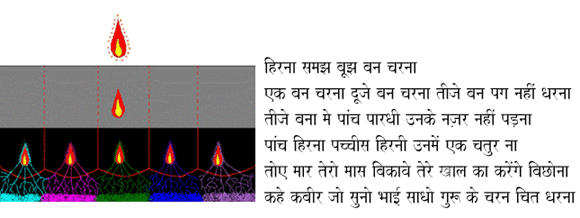Apr 18, 2025
Apr 18, 2025
Hirna Samajh Boojh Ban Charna
Ek Ban Charna Duje Ban Charna Tije Ban Pag Nahin Dharna
Tije Ban Mein Panch Paardhi Un Ke Nazar Nahin Padna
Panch Hirana Pachis Hirni Un Mein Ek Chatur Na
Toye Mar Tero Mas Bikawe Tere Khal Ka Karenge Bichona
Kahe Kabira Jo Suno Bhai Sadho Guru Ke Charan Chit Dharna

Translation
Oh Deer Graze With Knowledge and Discrimination
Graze in the First Forest, Graze in the Second Forest
But Don't Tread into the Third Forest
The Third Forest has Five Hunters
Don't Let them See You
Five Deer and Twenty Five Female Deer
None Among them is Sensible and Shrewd
Killing You They Will Sell Your Flesh
Your Skin will be Used as a Covering
Says Kabir Listen Oh Practicing Aspirant
Offer your Mind at the Feet of the Guru
Explanation
Traditionally, in Indian spiritual terminology, the Deer symbolizes the senses. However, the more latent meaning of a Deer is our pleasure-seeking desire. Fundamentally, each one of us is looking for pleasure and that search is what is alluded to, in this song, as the grazing of the deer.
The "third" forest is the physical reality guided by our senses. The "second" forest is the mental world that is guided by our mind/intellect - included in this are the visions and sounds heard by sages in meditation. Perhaps, Kabir does not see the internal visual and sound experiences much different from a mental state where thoughts are the driving force. The "first" forest is the true spiritual realm where oneness with the ultimate is complete. So he says its okay to graze in the first forest of oneness and the second forest of meditation/practice but not in the third forest of physical and sensual pleasures.
Why? He explains that in the third forest the pleasure-seeking tendency is at the mercy of the five sensual stimuli (sight, sound, smell, taste and touch) that are the hunters. He warns that one should stay out of their line of attack/vision.
The deer identifies so completely with the five senses that it takes on the form of five deer seeking the pleasures offered in the third forest. Each of these five senses of perception combined with the five motor organs of action (mouth, hand, feet, excretory and reproductive) makes a combination of twenty five different ways (five multiplied with five) in which the physical world is experienced. While, none of these experiences are permanent, all twenty-five pleasure-seeking ways of the physical world continue relentlessly. Kabir says that none of these pleasure-seeking methods are shrewd enough to see this obvious truth.
Eventually this pleasure search at the physical level ends unsuccessfully with the five sensory hunters "killing" the spirit of the search. Each of these modes become non-living/dead reality that serve as mere external display for feeding, beautifying and adorning the physical world.
So what is the way out of this bleak and hopeless reality? Kabir explains that the root of this transient mode of pleasure seeking is the mind. And therefore instead of controlling the senses, the mind needs to be tamed. But that's a daunting task in itself. Therefore Kabir, in all humility, says that the mind should be offered at the feet of the Guru (within) to show the way, directing it inwards to the true storehouse of pleasure - one that is abundant with everlasting ecstasy.

|
Deep and analytical penetration on the nature and structure of THOUGHT… indeed a daunting task to tame the false but abiding Maya |

|
So nice in many ways..the translation, the list of the songs and the preserved comments. Thank you! |

|
I like the simple and effective solution that Kabir offers at the end of this complicated saga. |

|
Lucid explanation .Thankyou so much. Very relevant for all spiritual seekers! |

|
Soch soch maname kuch soch Ye soch hi kranti laayegi Sochenge to kar payenge karne se aadat pad yaayegi Aadat hi apani humko Apni pehchan dilayegi pehchan humari ant hume Apna makaam dikhalayegi To sochenge tabhi kar payenge Ye soch hi kranti laayegi... Sochne ke liye saral man chahiye Kabirdasji ke kathan sashwat satya hai jai ho... |

|
Thanks for the excellent explanation of this wonderful bhajan by Kabir. |

|
Explanation is good |

|
Thank you very much for the explanation. It's beautiful. Appreciate your efforts. |

|
thank you so much for your effort! You gave me a wonderful gift here. |

|
Beautifully explained ... now that I begin to understand it, I think I will be able to sing the lovely bhajan in a way that will reach the audience ... Many thanks for the direction.... |

|
Thanks a lot.... |

|
Nice Translation! and great Job!! Thanks Prashant |

|
hv been listening to kumar gandharva since long who hs sng nirgun k gun etc of kabeer das ji...bt i wanted to know the meaning...my 10yrs long thirst to know the meaning is qunched a little and many more i want to know...are you a spiritual person? Hw did u cm to knw the meaning?its an overwhelming experience... |